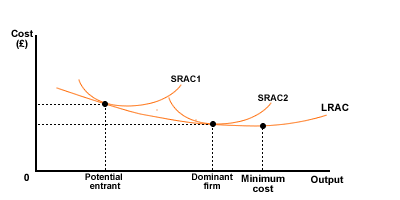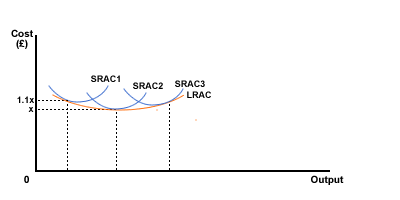Long run cost curves
The long run cost curve of a firm is sometimes called an 'envelope' curve as it envelopes all the short run average cost curves. Consider the different ways that capital intensive and labour intensive industries develop. First, some definitions:
- Capital-intensive firm - firm where its cost structure is dominated by fixed costs.
- Labour intensive firm - firm where its cost structure is dominated by variable costs (this may be, but does not have to be labour).
- Cost structure - the relationship between fixed and variable costs for a firm.
Capital-intensive activities have long, deep long-run average cost curves. Small firms cannot compete against large ones; the difference in average cost is too great. A few large firms, with perhaps a few small but very specialist businesses, will dominate industries. Examples here would include the petro-chemical industries. Look at Figure 2.

Figure 2 Long-run AC curve for capital-intensive business
Labour intensive activities have short and relatively flat long-run average cost curves. There is little advantage in being large, so the industry develops with many small firms. Examples would include the fishing industry in Asian countries where the industry comprises many family-run firms using basic fishing equipment and small boats. Look at Figure 3.

Figure 3 Long-run AC curve for labour intensive business
This means that it is very expensive to try to enter a capital-intensive industry. The minimum scale of operation will be high and will require a large investment of capital. The risk will be high, and the capital will be hard to raise. The cost becomes a real barrier to entry. The potential reward, however, will be large.
On the other hand, it is much easier to enter a labour intensive industry. The minimum scale of operation will be low, as will be the initial capital investment. The risk will be low, and not much capital will need to be raised. Cost will not be a barrier to entry, but the potential rewards are also smaller.

1 |
Economies of scaleMatch the following examples of economies of scale with their classification. |
2 |
Capital and labour intensiveWhich of the following industries would you expect to be capital intensive? (Select all appropriate answers) |
